Is Genesis Mining Worth it? A Genesis Mining Profitability Calculator You'll Actually Use
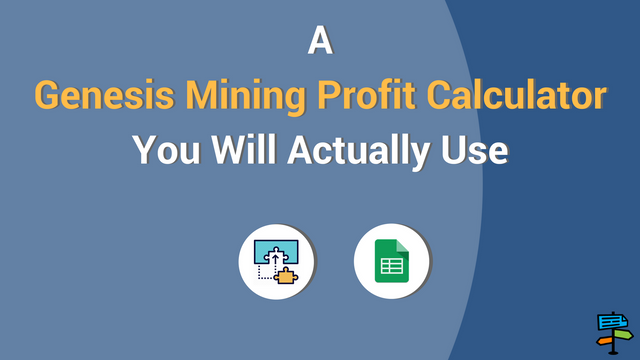
BitPay is on pace to process over $1B annually in bitcoin payment acceptance and payouts, and has already grown their payments dollar volume 328% year-over-year, according to a recent blog post on the BitPay website.
The very nature of cryptocurrencies requires transactions to be verified by miners. What does this mean?
- Cryptocurrency transactions are verified by a network of nodes, then recorded in a publicly distributed ledger known as a “blockchain”, which authenticates the coins as monetary units of measurement – or money.
- Cryptocurrency mining refers to coins created as a reward in which the users of the network verify and record transactions on this very blockchain. Users who are able to successfully verify the transactions receive fees and rewards in the form of brand new coins.
And Genesis Mining stands as the largest cryptocurrency cloud mining company in the world.
A user can rent "hashing power" in the form of a two-year contract from Genesis for a one-time, upfront fee.
In turn, they receive daily payouts of whatever specific cryptocurrency they purchased the contract for.
THE PROBLEM
While Genesis Mining has done a great job breaking down a complex problem into an easy-to-understand business model, users consistently have one big question:
"How profitable is {x} contract?" - Everybody, ever
While the user is able to see the upfront cost, they are unable to get an idea of how many coins they will receive by the end of the contract.
WHY THE PROBLEM EXISTS
The problem exists, because of two major uncertainties surrounding cryptocurrencies:
- Where the price of the currency will fluctuate over time
- Where the network hashrate (aka, the mining power of the entire network) will fluctuate over time
Both of these inputs are extremely volatile, and have a huge degree of uncertainty in the near and distant future.
What I will attempt to do in this exercise, is build a profitability calculator for Ethereum, Monero, and Zcash. Each of these cryptocurrencies is currently available on the website as of 11/7/2017.
Each cryptocurrency has three contracts, and I will formulate 4 different scenarios to try and capture a profitability "range".
Note: Do not take any of the words in this post as financial advice or recommendations. These are merely simulations that have their own issues and pitfalls, and are not to be used as the end-all, be-all decision.
THE ASSUMPTIONS
Due to the difficulty in forecasting both price and nethash, I was forced into a few assumptions:
- The forecasted price method is a Monte Carlo simulation using a geometric Brownian Motion ran 1,000 times. I covered the full methodology in a prior blog post
- The base network hashrate follows along very closely with the movements in price. This assumption I am the least confident about, as network hash has been shown to deviate at certain times
- I attempt to cover the shortfall in network hash rate with two different scenarios (shown below).
- I assume we hold all coins until the end of the contract, and assign a value to the portfolio based on $USD
- I do not run any scenarios of converting a currency into another currency
- I do not account for any significant changes to the underlying algorithm, such as the "Casper" Ethereum update (see 'THE DIFFICULTY BOMB' below)
Obviously any slight change could drastically alter these assumptions, but let's take a look at the different scenarios.
THE SCENARIOS
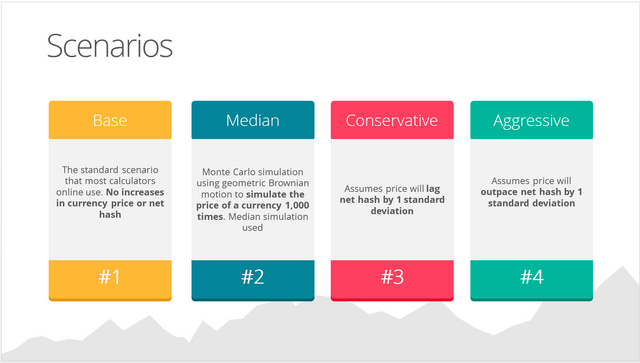
Instead of calculating just a base scenario (which every other calculator on the web does) I wanted to come up with different scenarios to get an idea of what could be.
- Base - Assume no change in price or network hashrate for the duration of the contract
- Median - Run a full 1,000 trial simulation of prices and network hash rate, and use the median values for each
- Conservative - The same as Median, but instead use a price forecast that is 1 standard deviation below the median price
- Aggressive - The same as Median, but instead use a price forecast that is 1 standard deviation above the median price
APIs USED
- Spreadstreet Google Sheets Add-in
- Bitfinex API - To pull in historical data for each currency
- WhatToMine API - For nethash statistics
- CoinMarketCap - Updated prices
ETHEREUM
The only way to utilize Ethereum is with the product from mining.
But this shortchanges the additional value of mining Ether. It is also absolutely required for securing the Ethereum network as it creates, verifies, publishes, and propagates blocks in the blockchain.
The overall term "Ethereum Mining" is the process of mining Ether.
Ether is an absolute essential, as it serves as fuel for the smooth running of the Ethereum platform.
Ether is used as an incentive to motivate developers to create top notch applications.
THE DIFFICULTY BOMB
Sometime in the future (we can't be certain when), ethereum will likely switch from its proof-of-work consensus algorithm to Casper, a proof-of-stake system its developers are now in the throes of completing.
From Blockonomi:
As opposed to the PoW consensus protocol, the PoS protocol achieves consensus through stakers—sometimes referred to as minters, too—who “stake” their coins by locking them down in specialized wallets.
With these stakers at work, mining will become redundant, meaning the Ethereum network post-Casper will rely on stakers and staking pools instead of miners for its operability.
Genesis Mining has a prelim plan in place for this scenario:
The Ethererum Mining plans will run for a maximum of 24 months, however, should Ethereum (“ETH”) switch to proof-of-stake before the end of the term, we will use the leased hardware on a best-effort basis to mine the most profitable coin with that hardware for you.
Very simply put, this changes the economics of contract profitability significantly. We are going to ignore that update for now, but it may make sense to stay away from the contracts in the short-term.
THE CONTRACTS
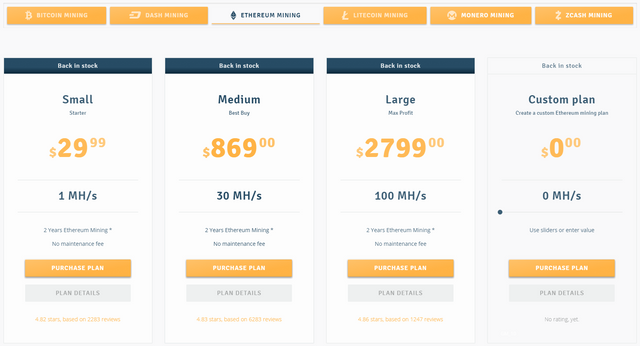
ONE-YEAR PRICE FORECAST

Here we can see one of 1,000 price simulations run to inform our forecast for the Median, Conservative, and Aggressive scenarios.
Base Price: $298.85 (Close as of 11/8/2017)
Median: $1079.74
Conservative: $338.91
Aggressive: $3,761.41*
*Why is the price so high? This is what happens when you have a volatile currency in a simulation that does not have changes in said volatility. When a currency can move 20% in one day, it is not uncommon to see price movements like this. I mean, shit, Ethereum grew 25x in one year.
RETURN ON INVESTMENT
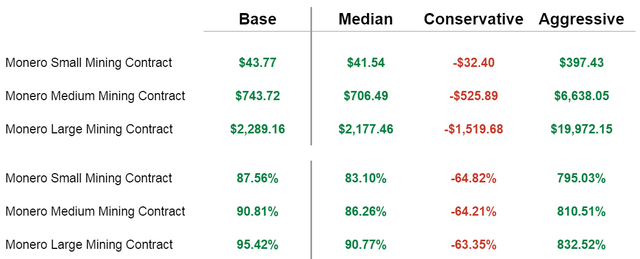
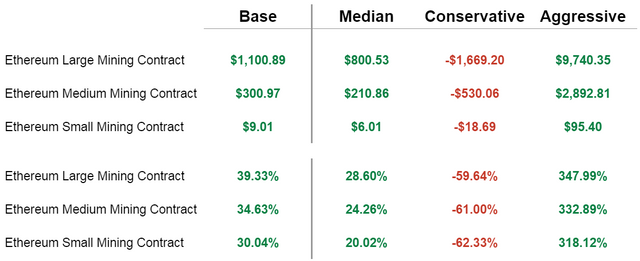
VERDICT
Base performance ranges from 30% to 39% ROI, and is higher than the Median scenario by ~10%.
The conservative scenario shows a loss of between 59-62%, and the aggressive scenario shows a gain between 318% and 347%.
Difficulty bomb in the near-future presents tremendous uncertainty.
MONERO
From Cryptocompare:
Monero (XMR) is a Cryptonote algorithm based cryptocurrency, it relies on Ring Signatures in order to provide a certain degree of privacy when making a transaction. Monero is a Proof of Work cryptocurrency that can be mined with computational power from a CPU or GPU. There are currently no ASICs for Monero, which means that anyone with a computer can mine it.
THE CONTRACTS
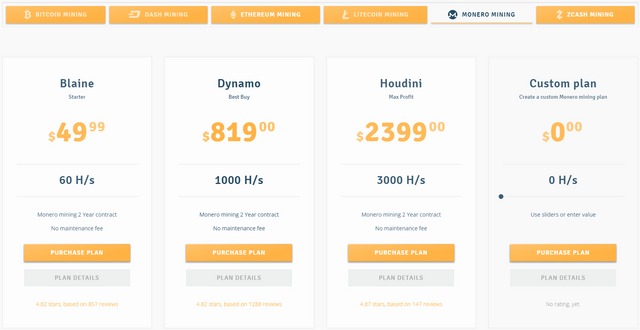
ONE-YEAR PRICE FORECAST

We run the same Monte Carlo simulation to inform our forecast for the Median, Conservative, and Aggressive scenarios.
Base Price: $104.54 (Close as of 11/8/2017)
Median: $1,973.36
Conservative: $379.16
Aggressive: $9,646.41*
Why is the price so high?
See Ethereum up above.
How is it possible for the "Conservative" scenario to be higher than the base price?
Good question, and i'm glad you brought it up. The Monero currency has been not only really volatile, but drifting upwards at a pretty high rate.
The results are also being skewed by a recent uptick on November 6th where the price jumped by ~18%.
This may represent an opportunity for contract investment, but more analysis is needed.
RETURN ON INVESTMENT

VERDICT
Base performance ranges from 87% to 95% ROI, with performance in the Median scenario lower by 5-6%.
The conservative scenario shows a loss of between 63-64%, and the aggressive scenario shows a gain between 795% and 832%.
To reiterate, the aggressive scenario is very much influenced by the recent uptick in volatility, so be weary of those high numbers.
ZCASH
ZCash uses Equihash as an hashing algorithm, which is an asymmetric memory-hard PoW algorithm based on the generalized birthday problem (I don't know what the hell this means, but it sounds fancy).
It relies on high RAM requirements to bottleneck the generation of proofs and making ASIC development unfeasible, much like Ethereum.
THE CONTRACTS

ONE-YEAR PRICE FORECAST

Here we can see one of 1,000 price simulations run to inform our forecast for the Median, Conservative, and Aggressive scenarios.
Base Price: $246.20 (Close as of 11/8/2017)
Median: $616.55
Conservative: $155.78
Aggressive: $2,327.43*
*Why is the price so high? See: Ethereum up above.
RETURN ON INVESTMENT
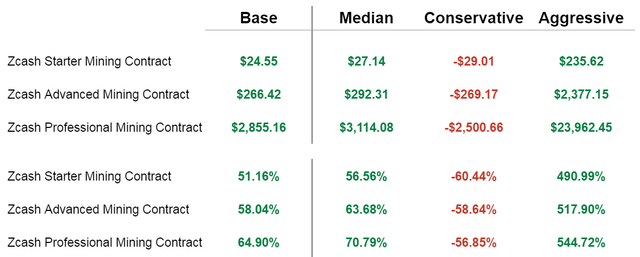
VERDICT
Base performance ranges from 51% to 65% ROI, and surprisingly lags the Median scenario by 4-6%.
The conservative scenario shows a loss of between 56-60%, and the aggressive scenario shows a gain between 490% and 540%.
CONCLUSION
The initial upfront costs and potential profitability are hidden when investing in hashing power contracts like Genesis Mining.
However with some robust analysis, we can get a better idea of how to assess the potential profitability of a two-year deal.
As we continue to evolve our thinking, better methods and analysis will eventually surface. Hopefully this industry can become a great avenue for side income.
If you want your own copy of the analysis and calculations, you can find it here:
Cheers, and happy hunting!
RELATED POSTS
How to Create an Ethereum Mining Calculator from Start to Finish
10 Statistical Price Predictions for 10 Cryptocurrencies
Bitcoin Madness: How to Simulate Bitcoin Prices in Google Sheets

